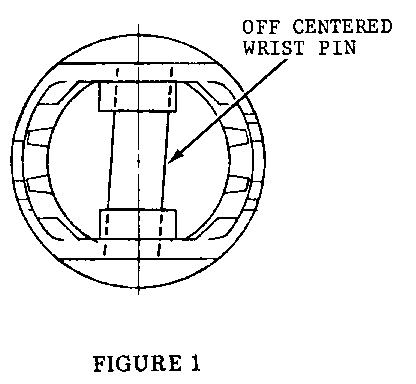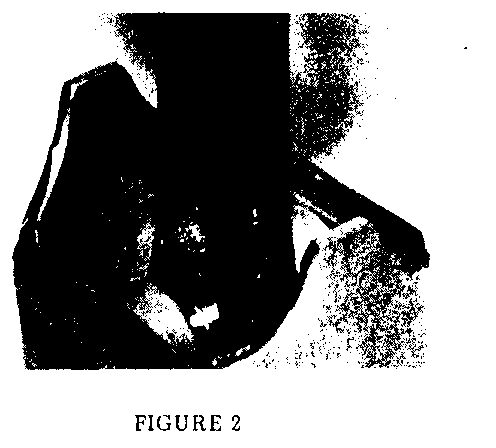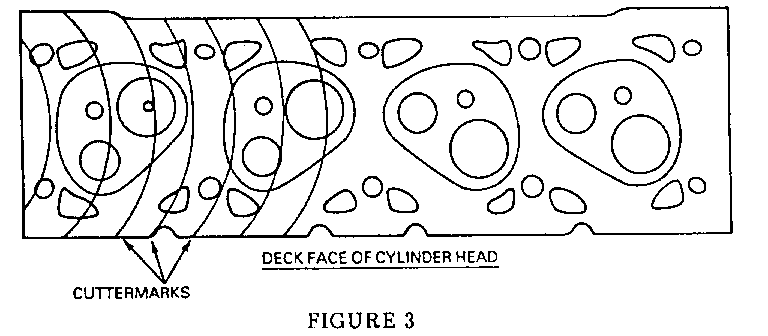ENGINE UPDATE NOISE DIAGNOSIS INFORMATION

HT4100 ENGINE UPDATE
This bulletin contains HT4100 service information covering loose exhaust manifold bolts, oil economy, engine noise and internal coolant leaks.
I. EXHAUST MANIFOLD BOLTS
A new exhaust manifold to cylinder head bolt (P/N 1626193) is available from GMWDD. This new bolt incorporates a torque prevailing feature and should be used when servicing loose exhaust manifold bolts on HT4100 engines.
II. OIL ECONOMY
The following information will provide assistance when assessing and diagnosing HT4100 engine oil consumption conditions:
A. General Information
1. When a comment concerning oil economy is received, the information provided by the owner should be noted.
2. Some drain back time is required after stopping the engine before an accurate dipstick reading can be obtained. About 2-3 minutes would appear to be the minimum. Five to 10 minutes is optimum.
3. Sometimes short fills occur in production. If a car is delivered this way, the owner may assume an economy condition exists the first time the oil is checked.
4. Determine that the proper viscosity oil is being used. Thin oils have higher consumption rates than thicker ones.
5. A careful inspection should be made of the PCV system. An unseated PCV valve or kinked or collapsed hose can cause excessive oil consumption. A restricted PCV system can also cause rapid oil deterioration and possible premature wear to the camshaft and valve lifters. Changing the valve and/or hose is usually the correction. Oil accumulation in the air cleaner and excessive wetting of the element is a clue that the PCV system should be carefully inspected.
6. A controlled test should be initiated after it is verified that the oil economy condition is not due to external leakage or any of the above.
7. At least 3,000 miles are normally required to obtain a valid test of the oil economy. An exception to this would be gross consumption cases of 500 miles/quart or less that indicate a serious condition exists and immediate corrective measures should be taken.
B. What to look for when diagnosing an engine after verifying that excessive oil consumption is occuring:
1. A loose intake manifold allows oil to be drawn into either the intake ports or exhaust heat crossover passages resulting in excessive consumption.
2. Piston rings:
A. Compression ring gaps lined up - particularly on several cylinders.
B. Missing or broken piston rings.
C. Oil ring expander missing or overlapped and not exerting pressure on the oil ring rails.
D. Piston rings (i.e., compression ring) installed upside down - the dimples should always be on the top.
E. Rings stuck in the grooves or excessive side clearance.
F. Scuffed rings or scored bores (usually go together).
3. Mismachined cylinder - This would be observed visually as a low spot where the rings failed to contact the cylinder wall or many small holes in the bored surface or a cylinder that was bored oversized and only partially honed (i.e., boring tool marks showing).
4. Missing or broken valve stem seals - particularly on the intake valves.
5. Excessive valve guide wear - particularly on the intake valve guides.
III. ENGINE NOISE
The following information will supplement the 1982 Cadillac Service Information Manual when diagnosing and correcting internal HT4100 engine noises. When diagnosing a suspected engine noise, the accessories and drive belts should be investigated as a possible source of the noise. Loose accessories and/or mounting brackets or overtensioned belts may cause a noise which could be misdiagnosed as an internal engine noise. The inforination contained in Serviceman Bulletin 82-21, Group 6A, should also be reviewed to assure that the noise is not originating from the flexplate-to-crankshaft attachment.
A. "Piston Slap", "Metallic Knock", and "Mallet" Noises
Three types of internal knocking noises reported on HT4100 engines are:
1. A "piston slap" noise caused by incorrect piston size or position. This noise is louder on a cold engine and can normally be reduced or eliminated by briefly "shorting out" cylinders one at a time with the engine running.
2. A "metallic knock" type noise caused by contact between the piston skirt(s) and the counterbalance weight(s) on the crankshaft. Number 1, 2, 3, 6, 7 and 8 piston skirts are designed to operate close to the crankshaft counterweights on the HT4100 engine and may contact each other as the aluminum pistons expand due to normal engine temperature increases. This noise is usually more prevalent on a hot engine and cannot be shorted out. This type of contact should be visible as a notch or cut in the affected piston skirt(s).
3. A "mallet" type noise that may sound somewhat hollow may also be caused by interference between the piston skirts and the counterbalance weights. The affected pistons, number 1, 2, 3, 6, 7 and/or 8, may not show visible signs of contact. This noise will normally be more apparent on a hot engine between speeds of 800 and 1400 RPM under very light acceleration from a stop. Disconnecting the EST connector under these conditions may change or eliminate this noise.
The service procedure listed below should be used to correct any HT4100 engine noises caused by incorrect piston and/or piston skirt/crankshaft interference:
Service Procedure
1. Remove the engine oil pan and cylinder heads as outlined in the 1982 Service Information Manual.
2. Inspect all pistons for correct installation. The piston notches should be positioned toward the front of engine as shown in Figure 6A8-48 on page 6A8-26 of the 1982 Service Information Manual. Any piston installed with the notch to the rear of the engine is 180 DEG out of position and should be rotated to the correct orientation.
3. Using a yellow wax pencil, mark the side of the outboard piston skirts (right or passenger side skirt on right bank and left or driver's side skirt on left bank) that rotate next to the crankshaft counterbalance weights on number 1, 2, 3, 6, 7 and 8 pistons.
4. Remove all 8 pistons and visually inspect for off-centered piston wrist pin(s) (refer to Figure 1).
When cases of extrernely off-centered piston wrist pins are encountered, which result in heavy interference of piston skirt to crankshaft, replacement of the piston/liner assemblies will be required.
5. Using a half-round file, remove a small amount of material from the number 1, 2, 3, 6, 7 and 8 piston skirt edges, marked in step 3, as illustrated in Figure 2. Extreme care must be taken when filing pistons to assure the piston skirt edge is very smooth and no file marks or scratches are left in the reworked area of the piston.
If interference marks are evident in the piston skirts, and filing a small amount of material from the skirts, as illustrated in Figure 2, does not remove the marks, replacement of the piston/liner assembly is required.
6. Reinstall the pistons in the block. (If pistons were replaced in steps 4 or 5, the new service pistons must also be filed when installed in the number 1, 2, 3, 6, 7 and 8 cylinders.)
7. Check the piston skirt-to-crankshaft counterweight clearances. This can be done using card stock (i.e., index card) as a feeler between the skirts and counterweights while rotating the crankshaft. A lack of sufficient clearance will be evident by drag on the f eeler. If lack of sufficient clearance is evident, replacement of the crankshaft will be required.
8. Reinstall cylinder heads and oil pan as outlined in the 1982 Service Information Manual.
For warranty purposes use labor Operation J1307 at 8.8 hours (C-car) and 9.5 hours (E/K-car) with a .4 hour ADD for each piston reworked. If piston replacement is required, existing Labor Time Guide "piston/liner" time allowances and appropriate ADDS should be used as published for Operation J1307.
B. "Piston Squeak" Noise
An engine "squeak" may be caused by a poor cylinder liner finish. If the honing operation fails to remove all the final bore operation tool marks, the piston rings may "squeak" as they pass over the ridges. The affected cylinder liner and piston should be replaced to correct this condition.
IV. INTERNAL COOLANT LEAKS
When diagnosing internal coolant leaks on an HT4100 engine, it is recommended the following areas be checked:
1. Cylinder Heads for cutter marks (refer to Figure 3).
2. Cylinder Liners for cracks and/or proper liner height.
These conditions are sometimes accompanied by "bubbles in the coolant", a very clean combustion chamber (top of piston, valves, etc.) and/or evidence of rust in the cylinder(s). Cylinder heads which exhibit cutter marks and cylinder liners which are cracked must be replaced.




General Motors bulletins are intended for use by professional technicians, not a "do-it-yourselfer". They are written to inform those technicians of conditions that may occur on some vehicles, or to provide information that could assist in the proper service of a vehicle. Properly trained technicians have the equipment, tools, safety instructions and know-how to do a job properly and safely. If a condition is described, do not assume that the bulletin applies to your vehicle, or that your vehicle will have that condition. See a General Motors dealer servicing your brand of General Motors vehicle for information on whether your vehicle may benefit from the information.
